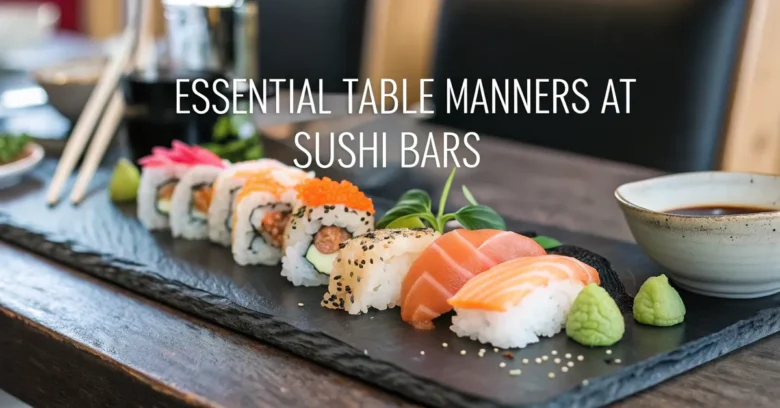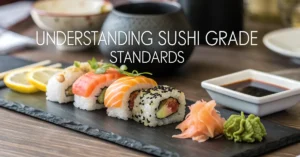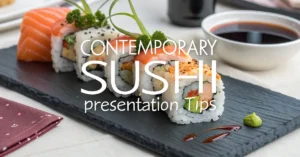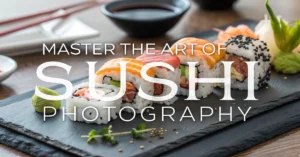Imagine stepping into a sushi bar for the first time. The gleaming wood, the quiet murmur of conversation, the focused intensity of the chefs – it’s an experience! But along with the delicious food comes a set of unspoken rules. These aren’t hard and fast dictates, but knowing them will enrich your experience and show respect for the establishment and its traditions. Understanding sushi bar table manners can appear daunting, but they are, in essence, centered on consideration and respect for the sushi, the chef, and your fellow diners.
Here’s what you need to know to navigate your first sushi bar visit with grace.
Essential Table Manners at Sushi Bars
Before You Sit: Making Reservations and Choosing Your Spot
Reservations: A Sign of Respect
While some casual sushi spots welcome walk-ins, making a reservation, particularly for a high-end or popular establishment, is always good table manners. It shows respect for the restaurant’s time and allows them to prepare for your arrival.
Where to Sit: Counter vs. Table
The quintessential sushi experience involves sitting at the counter, also known as the itamae. This puts you face-to-face with the chef, allowing you to observe their artistry and engage in conversation. If you’re a sushi newbie, don’t be shy! The chef is often happy to guide you through the menu and offer recommendations.
If you prefer a more private setting or are with a larger group, a table is perfectly acceptable. However, keep in mind that you’ll be further removed from the action and may miss out on some of the personalized attention.
The Art of Arrival: Setting the Stage for a Pleasant Meal
Dress Code: Relaxed Elegance
Most sushi bars don’t enforce a strict dress code. That said, aim for smart casual. Think clean, comfortable clothing that shows you put thought into your appearance. Avoid overly casual attire like beachwear or gym clothes.
Punctuality: Valuing Time
Arriving on time for your reservation is crucial. Sushi chefs often meticulously plan their preparations based on expected customer flow. Being late disrupts this delicate balance. If you anticipate a delay, call the restaurant to inform them.
Scent Sensibility: A Subtle Presence
Be mindful of strong perfumes or colognes. The delicate aromas of sushi are part of the dining experience, and overpowering fragrances can detract from the enjoyment of others.
Navigating the Table Setting: Tools and Condiments
Oshibori: The Cleansing Towel
Upon being seated, you’ll be presented with a damp towel, called oshibori. Use this to clean your hands before handling your sushi. It’s considered impolite to use it on your face or neck, though a quick dab at your forehead in a hot environment is usually tolerated. After use, neatly fold the oshibori and place it back on its holder.
Chopsticks: The Extension of Your Hand
Chopsticks are the primary eating utensil at a sushi bar. Here’s a quick etiquette guide:
- Handling: Hold chopsticks about one-third of the way down from the top.
- Resting: When not in use, rest your chopsticks on the chopstick rest (hashi-oki) provided.
- Passing: Never pass food directly to someone else’s chopsticks. This resembles a Japanese funeral ritual of passing cremated bones.
- Stabbing: Avoid stabbing food with your chopsticks. If you’re having trouble picking something up, gently ask for assistance.
- Pointing: Don’t point with your chopsticks.
- Licking: Do not lick your chopsticks.
- Waving: Avoid waving chopsticks around while talking.
- Placing Across Bowl: Do not place your chopsticks across the top of your bowl after you are finished eating. This is seen as a sign that you did not enjoy the meal.
- Vertical Placement in Rice: Do not stick your chopsticks vertically into a bowl of rice. This resembles incense sticks offered to deceased individuals, which is associated with Buddhist funerals.
Soy Sauce: A Measured Dip
Soy sauce (shoyu) is intended to enhance the flavor of the fish, not to mask it. Pour a small amount into the provided dish. The proper way to dip nigiri (sushi rice topped with fish) is fish-side down. This prevents the rice from soaking up too much soy sauce and falling apart. Avoid adding wasabi to the soy sauce; instead, apply a small amount directly to the fish.
Wasabi: A Touch of Heat
Wasabi, the fiery green horseradish paste, is a potent flavor enhancer. Use it sparingly, as too much can overwhelm the delicate taste of the sushi. If the sushi chef hasn’t already added wasabi to the nigiri, add a tiny dab directly to the fish.
Ginger: The Palate Cleanser
Pickled ginger (gari) is served to cleanse your palate between different types of sushi. This allows you to fully appreciate the unique flavors of each piece. It’s not meant to be eaten with the sushi.
Ordering with Finesse: A Dialogue with the Chef
Omakase: Trusting the Expert
If you’re feeling adventurous and trusting, consider ordering omakase. This translates to “I’ll leave it to you,” meaning you’re entrusting the chef to select the best and freshest offerings of the day. It’s a great way to experience a variety of flavors and preparations you might not otherwise try.
Asking Questions: A Sign of Interest
Don’t hesitate to ask the chef about the fish, its origin, or recommended preparations. Engaging with the chef demonstrates your appreciation for their craft.
Pacing Yourself: Savoring the Experience
Sushi is meant to be savored, not rushed. Order a few pieces at a time, allowing yourself to fully appreciate the flavors and textures. Ordering everything at once can overwhelm the chef and lead to a less enjoyable experience.
Eating Etiquette: Honoring the Sushi
One Bite at a Time:
Nigiri is typically designed to be eaten in one bite. If it’s too large, don’t be afraid to ask the chef to cut it in half.
Rice Respect:
Avoid crushing or deconstructing the nigiri. The rice is carefully prepared to hold its shape and complement the fish.
Using Your Fingers:
While chopsticks are customary, using your fingers to eat nigiri is perfectly acceptable, especially for men. Just ensure your hands are clean.
The Correct Side Down:
When eating nigiri, place the fish-side down on your tongue. This allows the flavor of the fish to hit your palate first.
Compliment the Chef:
If you enjoyed a particular piece of sushi, let the chef know! A simple “Oishii desu!” (It’s delicious!) is always appreciated.
Paying the Bill: Expressing Gratitude
Tipping:
Tipping practices vary. In some countries, like Japan, tipping is not customary and can even be considered rude. In other countries, like the US, tipping is standard practice. Check the local customs before you dine.
Expressing Gratitude:
Regardless of whether you tip, expressing your gratitude to the chef and staff is essential. A sincere “Arigato gozaimasu!” (Thank you very much!) goes a long way.
Common Mistakes to Avoid
Rubbing Chopsticks Together:
This implies that you think the chopsticks are cheap and need to be smoothed.
Leaving Food Behind:
It is respectful to try to finish all the sushi that you ordered.
Talking Loudly:
Keep your voice down and be respectful of other diners.
Sushi Beyond the Bar: Extending Etiquette to Takeout
Presentation Matters:
Even when enjoying sushi at home, take the time to arrange it neatly on a plate. This elevates the experience and shows respect for the food.
Proper Storage:
If you’re not eating the sushi immediately, store it properly in the refrigerator to maintain its freshness.
Respecting Ingredients:
Avoid adding excessive amounts of soy sauce or wasabi, even when dining at home. Let the natural flavors of the sushi shine through.
The Modern Sushi Bar: Adapting to Changing Times
Dietary Restrictions:
Inform the restaurant of any dietary restrictions or allergies when making your reservation. Sushi chefs are often happy to accommodate special requests.
Sustainability Awareness:
Choose sushi restaurants that prioritize sustainable seafood practices. This helps protect our oceans and ensures the availability of quality sushi for future generations.
Smartphone Etiquette:
Be mindful of your smartphone usage. Avoid talking loudly on the phone or taking excessive photos. Keep your phone silenced and out of sight as much as possible.
Deep Dive: The Cultural Significance of Sushi Etiquette
Sushi etiquette isn’t just about following rules; it’s about understanding and appreciating the cultural context behind them. These customs are deeply rooted in Japanese traditions of respect, mindfulness, and harmony.
Respect for the Chef:
In Japanese culture, chefs are highly respected artisans who dedicate years to mastering their craft. By following sushi etiquette, you’re acknowledging their skill and dedication.
Mindfulness and Appreciation:
Sushi is meant to be savored with mindfulness and appreciation. Each piece is carefully crafted to create a balanced harmony of flavors and textures. By eating with intention, you’re honoring the ingredients and the artistry that went into creating the dish.
Harmony and Community:
Sushi bars are often small, intimate spaces where diners share a communal experience. By following etiquette, you’re contributing to a harmonious atmosphere that enhances the enjoyment of everyone present.
The Future of Sushi Etiquette: Balancing Tradition with Modernity
As sushi continues to gain popularity around the world, its etiquette is evolving to reflect changing times and cultural norms. While some traditional customs remain important, others are becoming more flexible.
Embracing Inclusivity:
Modern sushi bars are becoming more inclusive and welcoming to diners of all backgrounds. Chefs are increasingly willing to explain etiquette to newcomers and adapt their offerings to accommodate dietary restrictions.
Sustainability and Ethics:
Consumers are becoming more aware of the environmental and ethical implications of their food choices. Sushi restaurants are responding by prioritizing sustainable seafood practices and promoting responsible sourcing.
Technology and Innovation:
Technology is also playing a role in shaping the future of sushi etiquette. Online ordering, digital menus, and contactless payment options are becoming increasingly common.
The Spirit of Sushi: More Than Just Manners
In the end, sushi etiquette is about more than just following a set of rules. It’s about approaching the dining experience with respect, mindfulness, and appreciation. By understanding the cultural context behind these customs, you can deepen your connection to the food and the people who create it. Whether you’re a seasoned sushi aficionado or a curious newcomer, embrace the spirit of sushi and let it guide you on a journey of culinary discovery. By respecting the traditions and embracing the evolving landscape of sushi culture, you can ensure that this beloved cuisine continues to thrive for generations to come.



